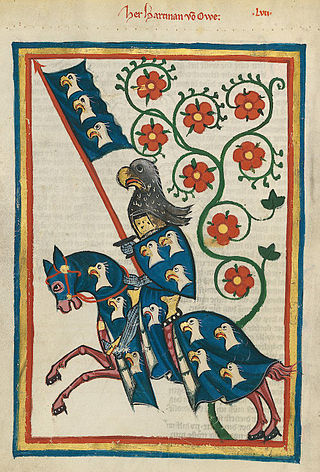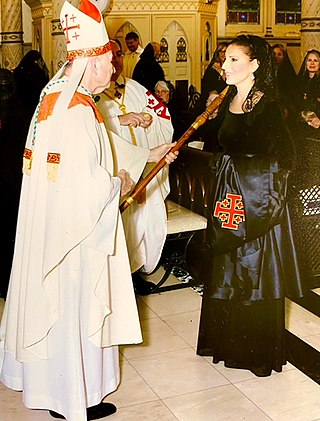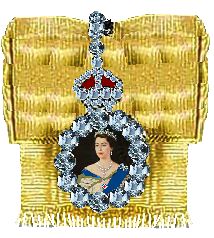
A knight is a person granted an honorary title of knighthood by a head of state or representative for service to the monarch, the church or the country, especially in a military capacity.
In the United Kingdom and the British Overseas Territories, personal bravery, achievement, or service are rewarded with honours. The honours system consists of three types of award:

The Most Noble Order of the Garter is an order of chivalry founded by Edward III of England in 1348. The most senior order of knighthood in the British honours system, it is outranked in precedence only by the decorations of the Victoria Cross and the George Cross. The Order of the Garter is dedicated to the image and arms of Saint George, England's patron saint.

The Most Excellent Order of the British Empire is a British order of chivalry, rewarding contributions to the arts and sciences, work with charitable and welfare organizations, and public service outside the civil service. It comprises five classes of awards across both civil and military divisions, the most senior two of which make the recipient either a knight if male or a dame if female. There is also the related British Empire Medal, whose recipients are affiliated with, but not members of, the order.
Sir is a formal honorific address in English for men, derived from Sire in the High Middle Ages. Both are derived from the old French "Sieur" (Lord), brought to England by the French-speaking Normans, and which now exist in French only as part of "Monsieur", with the equivalent "My Lord" in English.

The Most Ancient and Most Noble Order of the Thistle is an order of chivalry associated with Scotland. The current version of the order was founded in 1687 by King James VII of Scotland, who asserted that he was reviving an earlier order. The order consists of the sovereign and sixteen knights and ladies, as well as certain "extra" knights. The sovereign alone grants membership of the order; they are not advised by the government, as occurs with most other orders.

The Most Venerable Order of the Hospital of Saint John of Jerusalem, commonly known as the Order of St John, and also known as St John International, is an order of chivalry constituted in 1888 by royal charter from Queen Victoria and dedicated to St John the Baptist.

The Royal Victorian Order is a dynastic order of knighthood established in 1896 by Queen Victoria. It recognises distinguished personal service to the monarch, members of the royal family, or to any viceroy or senior representative of the monarch. The present monarch, King Charles III, is the sovereign of the order. The order's motto is Victoria. The order's official day is 20 June. The order's chapel is the Savoy Chapel in London.

The Equestrian Order of the Holy Sepulchre of Jerusalem, also called the Order of the Holy Sepulchre or Knights of the Holy Sepulchre, is a Catholic order of knighthood under the protection of the Holy See. The Pope is the sovereign of the order. The order creates canons as well as knights, with the primary mission to "support the Christian presence in the Holy Land." It is an internationally recognised order of chivalry. The order today is estimated to have some 30,000 knights and dames in 60 lieutenancies around the world. The Cardinal Grand Master has been Fernando Filoni since 2019, and the Latin Patriarch of Jerusalem is ex officio the Order's Grand Prior. Its headquarters are situated at the Palazzo Della Rovere and its official church in Sant'Onofrio al Gianicolo, both in Rome, close to Vatican City. In 1994, Pope John Paul II declared the Virgin Mary as the order's patron saint under the title "Blessed Virgin Mary, Queen of Palestine."
The fount of honour is a person, who, by virtue of their official position, has the exclusive right of conferring legitimate titles of nobility and orders of chivalry on other persons.
A dynastic order, monarchical order, or house order is an order under royal patronage. Such an order is bestowed by, as a legitimate fons honorum, a sovereign or the head of a once-sovereign ruling family. These are often considered part of the cultural patrimony of the ruling family. Dynastic orders were often founded or maintained to reward service to a monarch or their subsequent dynasty.

There were three Imperial Orders of the Mexican Empire, which were Orders of chivalry created to reward Heads of state and prominent people during the two periods of the Mexican Empire—the Imperial Order of Guadalupe, the Imperial Order of the Mexican Eagle, and the Imperial Order of Saint Charles.
Order of Beneficience is the name given to two different orders in Greece. One of them is conferred by the Greek royal family, and the other is conferred by the Greek government.

An order of chivalry, order of knighthood, chivalric order, or equestrian order is an order of knights, typically founded during or inspired by the original Catholic military orders of the Crusades and paired with medieval concepts of ideals of chivalry.

Dame is an honorific title and the feminine form of address for the honour of damehood in many Christian chivalric orders, as well as the British honours system and those of several other Commonwealth realms, such as Australia and New Zealand, with the masculine form of address being Sir. It is the female equivalent of a knighthood, which is traditionally granted to males. Dame is also a style used by baronetesses in their own right.

The Imperial Order of Saint Catherine was an award of Imperial Russia. Instituted on 24 November 1714 by Peter the Great on the occasion of his marriage to Catherine I of Russia. For the majority of the time of Imperial Russia, it was the only award for women; the Insignia of Saint Olga existed briefly from 1916 to 1917, but ceased with the fall of the Romanov dynasty.

The Order of Saint Elizabeth was an chivalric and charitable order for women in the Electoral Palatinate and the Kingdom of Bavaria.
A self-styled order or pseudo-chivalric order is an organisation which claims to be a chivalric order, but is not recognised as legitimate by countries or international bodies. Most self-styled orders arose in or after the mid-18th century, and many have been created recently. Most are short-lived and endure no more than a few decades.
The orders, decorations, and medals of the Holy See include titles, chivalric orders, distinctions and medals honoured by the Holy See, with the Pope as the fount of honour, for deeds and merits of their recipients to the benefit of the Holy See, the Catholic Church, or their respective communities, societies, nations and the world at large.

The sovereign of the United Kingdom may award a royal family order to female members of the British royal family, as they typically do not wear the commemorative medals that men do. The same practice is in place in the royal families of Norway, Sweden, Denmark, the Netherlands, Thailand, and Tonga. The order is a personal memento rather than a state decoration. It is therefore not announced in The London Gazette, and who held which decoration must be inferred from portraits and documents.













